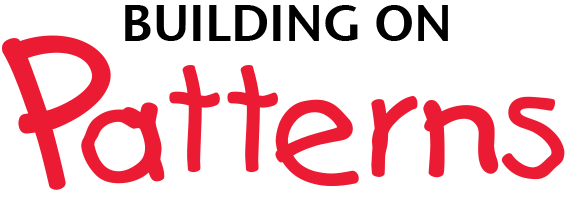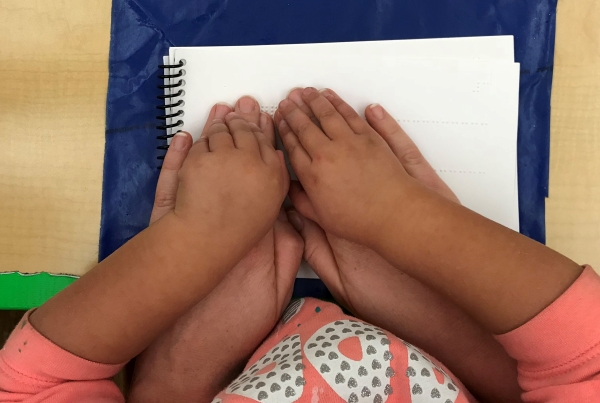
Building on Patterns is a systematic, comprehensive, and balanced literacy program designed to teach young children with visual impairments to read and write using braille.
Prekindergarten
This page contains a wealth of resources to support teachers of students with visual impairments as they use Building on Patterns Prekindergarten in early literacy programs with young braille-reading children. These resources are designed to provide teachers with additional background information, models of teaching techniques, and downloadable materials.
Resources
Contents
- FAQ
- Quick Start
- Videos and Photos
- Parent Letters
- Monitoring Charts and Reading Roundup Consumables
- Sample Filled-In Charts
- Audio Files for Songs Included in the Lessons
- Braille Labels for Children’s Books
- APH Digital Recording Device Instructions
FAQ
See answers to the most frequently asked questions.
Quick Start
This one-page “Quick Start" guide provides brief but important information for teachers about materials and information that can be used by teachers at the very beginning of their preparation for using Building on Patterns Pre-K.
These files are electronic versions of the hard copy included in the Teacher Kits.
Videos and Photos
Videos
Getting Started with Building on Patterns Pre-K
Getting Started with Building on Patterns Pre-K with transcript (YouTube)Opens a new window
Perkins Brailler: Inserting Paper
Perkins Brailler: Inserting Paper with transcript (YouTube)Opens a new window
How to Fix a Paper Jam in a Braillewriter
How to Fix a Paper Jam in a Braillewriter with transcript (YouTube)Opens a new window
Photos of Hand-under-Hand Support
In the three photos shown here, a teacher is sitting behind a child with her arms reaching around the child. The teacher’s hands are exploring a page or toy, demonstrating an activity from the child’s perspective and modeling hand movements. The child's hands "ride" on top of the teacher's. Hand-under-hand technique allows the child to be in control of his or her tactile exploration.
Exploring a toy: This photo shows a teacher using hand-under-hand technique to help a child explore a toy with a bumpy, flower-shaped top. The teacher's right hand is around the side of the top of the toy, and her left hand is reaching under the top. The child's hands are partially on top of the teacher's and partially on the toy.

Exploring a line of braille (2 photos): These two photos show a teacher using the hand-under-hand technique to demonstrate tracking a line of braille. In the first photo, the teacher's hands are side-by-side at the beginning of the first line of braille on a page. Three fingertips of her left hand and four fingertips of her right hand are on the braille. The child's hands are on top of the teacher's with her fingertips almost on top of the teacher's.

In the second photo, the teacher's and child's hands have slid to the right to track the line of braille.

Parent Letters
Printed hard copies are included in the Student Kit. However, it is recommended that you customize these to you, your student, and your student's family using the files linked below.
- Initial Letter to Parent and Observations Sheet – Attach these together and send them to the child’s family prior to starting BOP Pre-K. (.docx) (.brf)
Parent Letters for each lesson – There is one letter to go with each lesson. Send the corresponding letter to the child’s family on the first day of each lesson.
- .docx file with images of braille. This file is provided in case you are not able to install a new font on your computer.
- .docx file with the APH Braille Shadow font; download the font here
- .brf
Monitoring Charts and Reading Roundup Consumables
Printed hard copies are included in the Student Kit.
Ongoing Monitoring Charts
- Anecdotal Notes page
- Braillewriter Skills: Loading and Removing Paper
- Book and Page Orientation
- Name Writing
- Hand and Finger Movements for Writing
- Hand and Finger Movements for Reading
- Alphabet Knowledge Summary Checklist
Reading Roundup Charts (Lessons 10, 17, 25, and 32)
- Compiled Reflections from Reading Roundup Lessons and Monitoring Charts (Note: The pages in this file are numbered 1 to 10.)
- Reading Roundup Progress Chart: Accumulated Record
- Reading Roundup Summary and Planning Chart
- News and Notes for Parents – Print this 2-sided. Fill in the first/front page and send it to the child’s family after each Reading Roundup lesson. (.docx) (.brf)
Sample Filled-In Charts
The sample assessment charts (in .pdf and .docx format) are partially or fully completed to show how to record data about your student's progress. When reviewing them, please keep the following points in mind:
Some of the sample charts were handwritten, and others were completed electronically. Either approach to recording data is fine for any of the charts. So, if a particular sample chart shows handwritten data, it could just as easily be filled in electronically. (Note: Print transcriptions of the handwritten information are included in the .docx versions of the samples.)
The performance of the students documented in these assessment charts does not reflect typical or expected progress. When following the BOP Pre-K program, it is important to move at the child's pace, using the data collected to plan instruction and address needs. Your individual student may move at a faster or slower pace than shown in the sample charts.
These sample charts provide suggestions for how to fill in the various data collection charts; however, you will want to consider your student's individual goals when taking data. Some of the charts are purposely designed to be open-ended so that you can focus on your student's unique strengths and needs.
Sample Ongoing Monitoring Charts
When using a screen reader with the docx file linked below, please make sure it is set to read some punctuation. Bullets are used before items in place of circling.
Sample Reading Roundup Charts
When using a screen reader with the docx file linked below, please make sure it is set to read some punctuation. Bullets are used before items in place of circling.
(Note: A sample News and Notes for Parents is available in the Reading Roundup: Lessons 10, 17, 25, and 32 booklet.)
Audio Files for Songs Included in the Lessons
Below are audio files (.mp3) for the songs included in the lessons that are less likely to be familiar.
- Lesson 5: Oats, Peas, Beans, and Barley Grow
- Lesson 14: 5 Little Dinos
- Lesson 16: Emotions
- Lesson 26: 1, 2, 3, 4, 5 (two verses)
Braille Labels for Children’s Books
A set of print children’s books and a set of braille children’s books are included in the Student Kit. To create print-braille versions of the books, emboss the braille ready files (BRF) onto APH Braillable Labels and Sheets (Catalog Number 1-08874-00) or other braillable adhesive labels and apply them to the print copies of the books.
The files are set up so that the braille translation of each print page can fit within the length and width of the corresponding print page. There is a note under some of the book titles below to indicate instances where the braille translation will not fit on the print page; it includes the page(s) that will not fit, as well as a suggestion to emboss the runover text on paper and insert it into the book. The BRFs for each book can be downloaded by selecting the corresponding link below:
-
The braille translation of the print page that starts with “Mama and Papa beamed” in You Be You does not fit on the print page. The two additional braille pages of runover text can be embossed on paper and inserted into the book.
Lesson 7: What’s it like to be...a BUTTERFLY?
The braille translation of print pages 22–24 in What's it like to be...a Butterfly? does not fit on the corresponding print pages. The four additional braille pages of runover text can be embossed on paper and inserted into the book.
-
The braille translation of three print pages in The Gruffalo does not fit on the corresponding print pages. The three additional braille pages of runover text can be embossed on labels and applied to the facing print pages that have no text. The opening text for each page is as follows:
“A mouse took a stroll through the deep dark wood. A fox”
“On went the mouse through the deep dark wood. An owl”
“On went the mouse through the deep dark wood. A snake”
-
The braille translation of print pages 23 and 24 in Keeping Fit does not fit on the corresponding print pages. The three additional braille pages of runover text can be embossed on paper and inserted into the book.
Lesson 18: The Piggy in The Puddle
The braille translation for seven print pages in The Piggy in the Puddle does not fit on the corresponding print pages. The seven additional braille pages of runover text can be embossed on labels and applied to the facing print pages that have no text. The first line of text for each page is as follows:
“See her daddy,”
“See her mommy,”
“See her brother,”
“There was a piggy, plump and little,”
“See two piggies in the puddle,”
“See three piggies in the puddle,”
“See four piggies in the puddle,”
Lesson 20: What’s it like to be...a SPIDER?
The braille translation of print pages 22–24 in What's it like to be...a Spider? does not fit on the corresponding print pages. The four additional braille pages of runover text can be embossed on paper and inserted into the book.
Lesson 21: My Friend the Doctor
The braille translation of the print page titled “Note to Parents” in My Friend the Doctor does not fit on the print page. The five additional braille pages of runover text can be embossed on paper and inserted into the book.
-
The braille translation of the recipe on print pages 30 and 31 in Bee-bim Bop! does not fit on the corresponding print pages. The nine additional braille pages of runover text can be embossed on paper and inserted into the book.
Lesson 31: The Day the Crayons Quit
The braille translation for 11 print pages in The Day the Crayons Quit does not fit on the corresponding print pages. The 11 additional braille pages of runover text can be embossed on labels and applied to the facing print pages that have no text. The print pages affected are the following colors: red, purple, beige, gray, white, black, green, yellow, orange, blue, and pink.
APH Digital Recording Device Instructions

